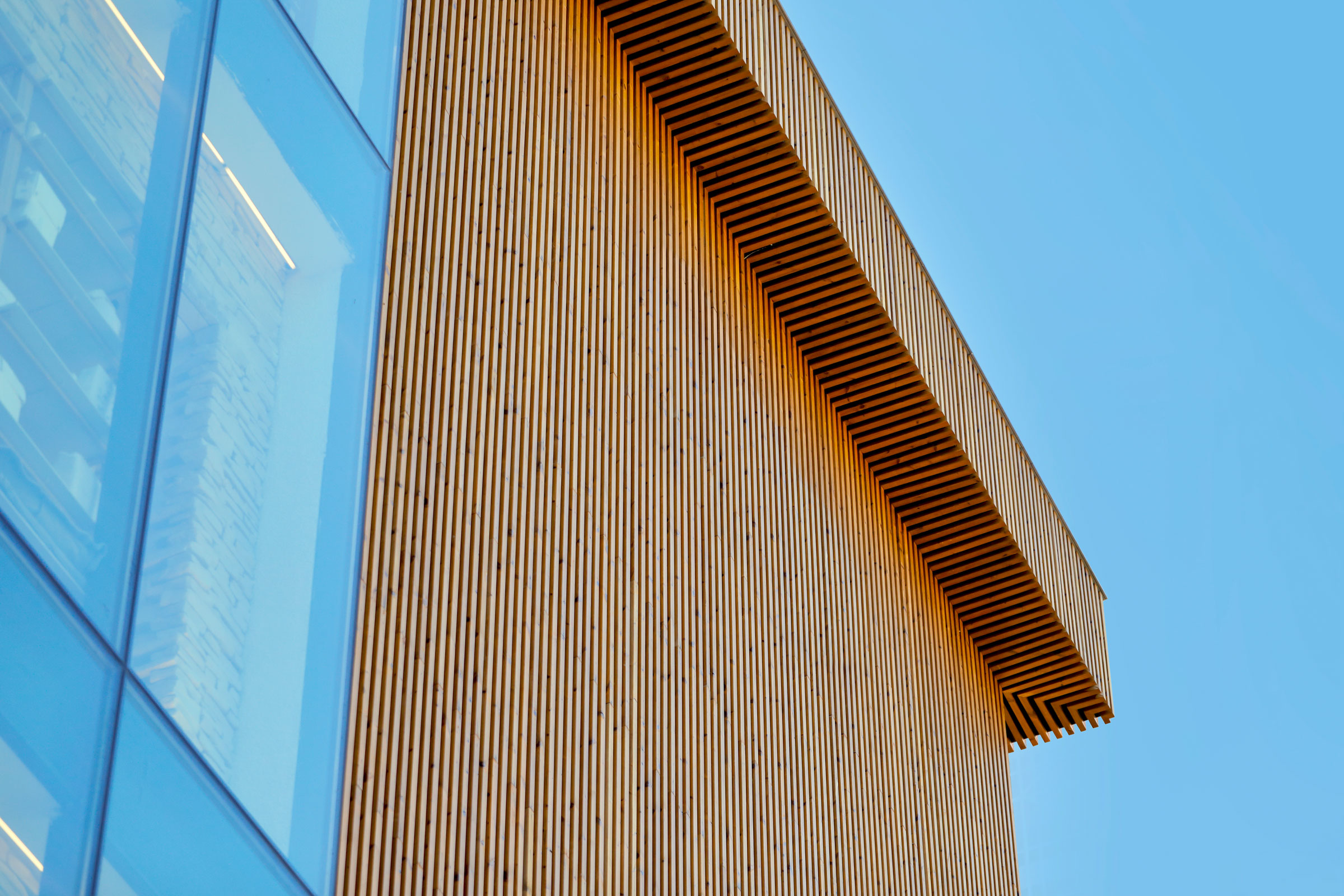Story at a glance:
- Thermally modified wood is wood that has experienced chemical change using heat and steam.
- The thermal modification process improves wood’s durability and stability while giving it a rich color.
- Many manufacturers are now offering thermally modified wood solutions for interior and exterior.
Thermally modified wood is defined as a natural wood product that has undergone some chemical changes using heat and steam to improve durability and stability. It can be used inside and out, and architects are increasingly turning to thermally modified wood for its many benefits.
According to Arbor Wood, the wood modification process was first developed by the VTT Technical Research Centre of Finland in the early ’90s.
“During thermal modification, select-grade kiln-dried wood is subjected to a secondary high-heat thermal modification kiln where a chemical process called hydrolysis occurs,” writes Arbor Wood’s Jon Heyesen in a previous article for gb&dPRO. “It is this breaking up of the hydroxyl groups in the wood’s cellular structure that increases both durability and biological resistance by permanently reducing the material’s tendency to absorb water and serve as a food source for mold, rot, fungal decay, and insects. The conversion of sugars to a nonfood source also turn the timber a darker, richer through-color, providing an appealing and refined aesthetic similar to the look of exotic hardwoods.”
Although wood species like ash, oak, and pine are most common, thermal modification can be performed on many species to varying degrees of success, Heyesen says.
Here we explore what some manufacturers of thermally modified wood offer and why.
Arbor Wood
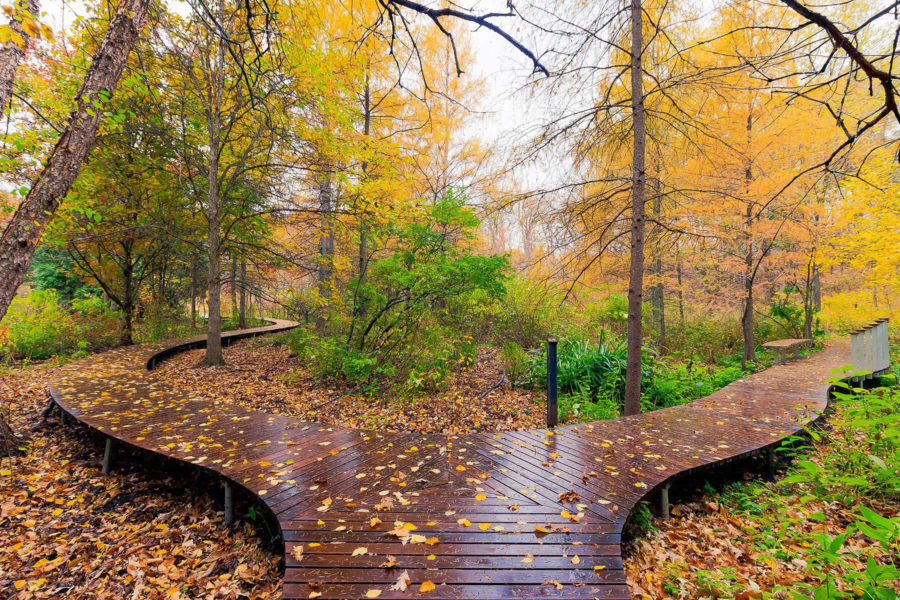
The Eloise Butler Wildflower garden is the first and oldest public wildflower garden in the United States. This Arbor Wood wetland boardwalk made use of local boulevard trees impacted by the emerald ash borer. The trees were harvested, modified, and milled to create a durable and long-lasting pathway to supports the park’s delicate ecosystem. Photo courtesy of Arbor Wood
Arbor Wood’s products have been used across projects—from outdoor gardens and exterior siding to interior applications like flooring and wainscoting.
The oldest public wildflower garden in the US, the Eloise Butler Wildflower garden, makes use of Arbor Wood for its wetland boardwalk. This project used local boulevard trees impacted by the emerald ash borer. “The trees were harvested, modified, and milled to create a durable and long-lasting pathway to support the park’s delicate ecosystem,” Heyesen says.
Those local trees impacted by the emerald ash borer were also given new purpose by being harvested, thermally modified, and milled to create the award-winning boardwalk. Heyesen says thermally modified wood is often used on exteriors because the process turns timber a darker, richer color, often making it look like a more exotic hardwood.
The award-winning Bell Museum of Natural History on the University of Minnesota campus is another example. It incorporated more than 21,000 square feet of Arbor Wood’s thermally modified white pine for its facade. The wood came from a forest just 30 minutes away from the building site.
“This process proved important to global architecture firm Perkins + Will,” Heyesen told us. “The project was intended to showcase the region’s natural history and called for a natural wood facade that was produced domestically, FSC-certified, installed without the need for finish or stain, and would last 25-plus years. Minnesota-sourced white pine was harvested, thermally modified, and milled to meet this requirement and was the largest commercial installation of white pine cladding in the country.”
Delta Millworks
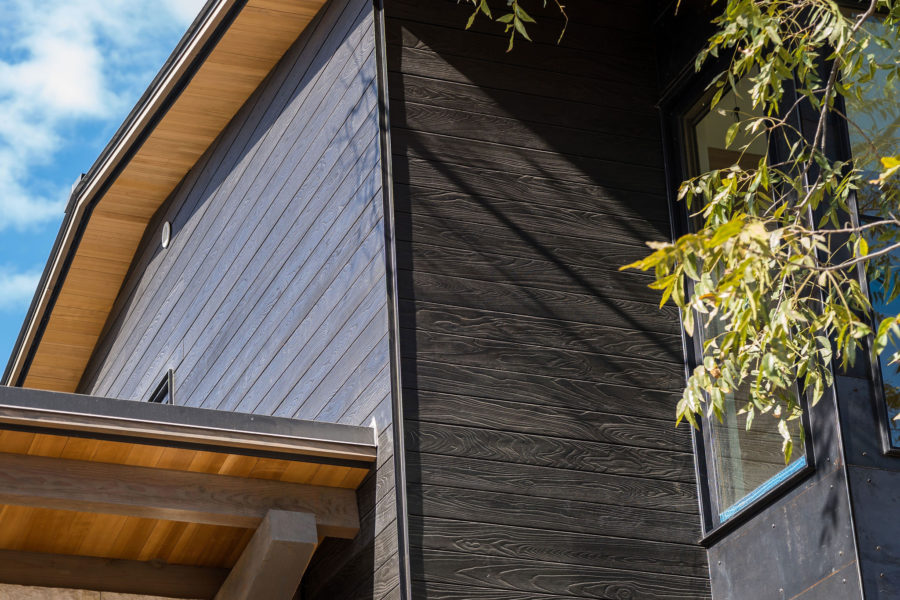
Thermally modified wood cladding from Delta Millworks’ Mojave collection is seen here on the Hatley project. Photo by Rob Gomez
Delta Millworks’ environmentally friendly, durable alternative also has a distinctive chocolate brown color and is sustainably sourced. The team at Delta Millworks says their product is lightweight and easy to work with, and it’s less impacted by changes in humidity that cause warping, cracking, shrinking. and swelling.
Their thermally modified Mojave collection is available in oak, hemlock, radiata, and Ponderosa pine. It features increased structural resistance to weather and decay, and the thermal modification process itself involves zero chemicals—furthering its sustainability.
“Beyond our commitment to sustainability and health, one of the other measurable differentiators is the long-term durability our products provide,” Robbie Davis, CEO at Delta Millworks, previously tells gb&d. “The adaptability of Delta Millworks is also key to our brand. Every single one of our products can be used for interior application. We work with designers and architects to select from wood species, Shou sugi ban or charred textures, and coatings, and we are also able to create custom finishes to achieve almost any aesthetic.”
The reclaimed wood and architectural millwork manufacturer dates back to 1985 and is based in Austin, Texas.
“Architects come to us—and come back to us—because not only are our products healthy, durable, and sustainable, but they are also engineered to be totally adaptable and customizable to the widest possible range of design outcomes,” Davis says.
Lunawood Thermowood
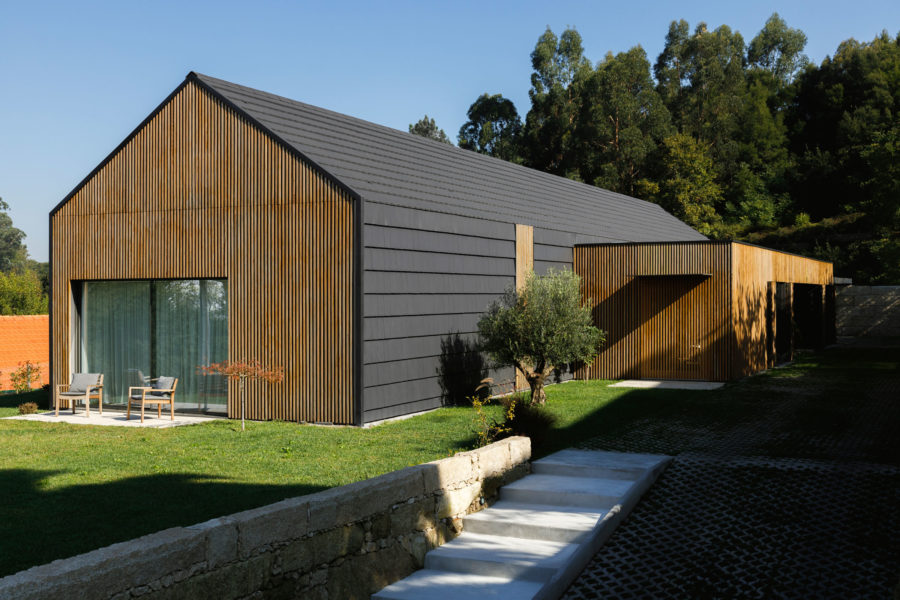
The Santo Tirso House in Portugal was designed by HOUS3 using black tile and thermally modified wood. Photo by Ivo Tavares Studio
The Santo Tirso House in Portugal designed by HOUS3 uses Lunawood Thermowood for its facade. Architect Fábio Costa says the thermally modified wood is a beautiful, sustainable material they wanted to use for its improved properties.
“Thermowood is dimensionally stable, resistant to decay, and a resin-free and non-toxic, natural product that is easy to machine and install,” he previously told gb&d.
Costa says the thermally modified wood also has a beautiful brown tone that naturally weathers over time to have a beautiful silver-gray patina.
Together on this project, the exterior’s thermally modified wood and black tile create an eccentric connection that’s comforting to look at. “The relationship is extreme between hardwood and industrial tile, but it works as a whole. Industrial black enhances the honey tone and natural gray oxidation of the wood,” Costa says.
Tantimber
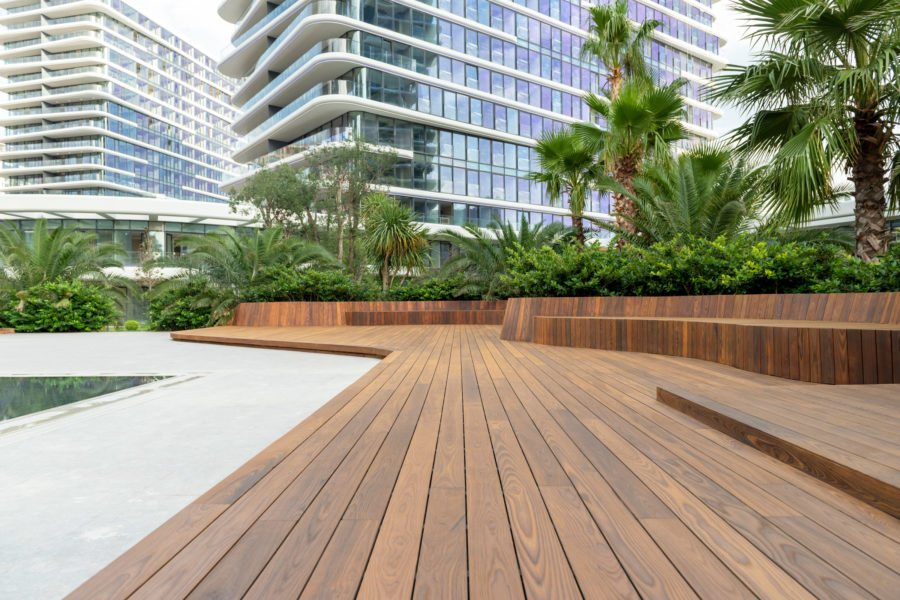
Thanks to the ThermoWood process, Tantimber products are durable, stable, and easy to maintain while having the added biophilic benefits of warmth and naturalness in design. Photo courtesy of G Wood Products
Tantimber offers a complete line of sustainable, thermally modified decking, siding, louvers, interior decorative wall coverings, laminated beams, and pergolas that are manufactured using a cutting-edge ThermoWood process. Their patented process starts with moving FSC-certified sawn timber to a kiln for high temperature drying. The temperature inside the kiln is raised to 212°C to prevent cracking. Then the moisture content of the wood is reduced to absolute zero.
The high temperature is maintained, which changes the wood chemically and physically, gives it its brown color, and removes harmful extractives. After high-temperature drying, the temperature is decreased by using steam and water. The moisture content of the wood is controlled to ensure end-products contain moisture levels from 4 to 7%, improving the wood’s dimensional stability and durability without the fear of cracking. This whole process can last up to 110 hours.
The process results in many benefits—from durability and stability to design flexibility, according to Mehmet Zenginler, cofounder and managing partner of G Wood Pro, the exclusive distributor of Tantimber ThermoWood products in the US.
As a result of the ThermoWood process, the chemical structure of the wood changes. Removing moisture and organic compounds leaves the wood extremely reliable, Zenginler says. In fact, ThermoWood Ash becomes strong as IPE, a South American species of wood commonly known as the iron wood. It’s much lighter than IPE, too.
“It doesn’t warp, swell, or shrink,” Zenginler says. “Even in extreme weather conditions or when used in different applications, like for saunas or docks on the ocean, it’ll keep it stability.”
And because thermally modified wood is resistant to moisture, it’s also resistant to rotting and molding and won’t become a home to bugs or fungi.
Thermory USA
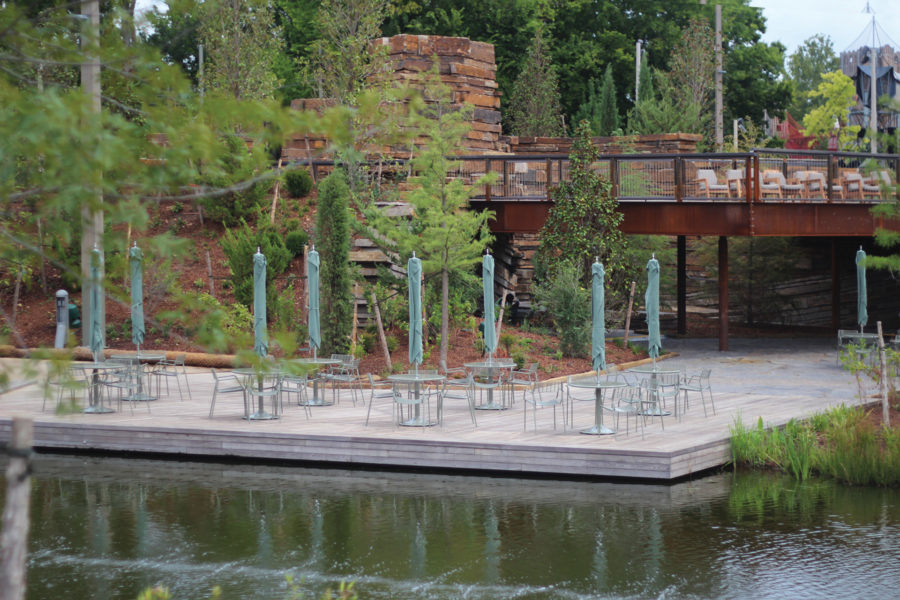
The Gathering Place in Tulsa was designed using custom benchmark ash decking and cladding from Thermory USA. Designer Michael Van Valkenburgh Associates. Photo by Ryoma Tominga
Thermory USA says it has fine-tuned the thermal modification process using steam to have more control. Their product is also thoroughly inspected before leaving Thermory’s factories, ensuring each board is straight, smooth, and beautiful—reducing waste.
“We are careful with how we source our wood. We have taken great care to understand how different forests and environments renew. We source from several locations around the world and make sure to leave all forests healthy and thriving. We never source from rainforests,” says Kevin DeMars, part-owner of Thermory USA, in a previous interview with gb&d. “Since our process makes the wood rot-resistant and stable we can source wood from the Northern Hemisphere. It mimics the qualities of tropical wood without deforestation or the use of plastics or chemicals like in pressure-treated or composite lumber.”
DeMars says the growing popularity of biophilic design has also put their product in demand. “It is ecological, beautiful, soft, and supple to the touch.”
One great example, he says, is The Gathering Place in Tulsa. World-renowned landscape architect firm Michael Van Valkenburgh Associates designed the park to be a nature-inspired retreat within a bustling city environment. Thermory’s Benchmark ash was used for decking and cladding.
In general, Thermory USA offers several species of wood, sizes, and colors. “We have textures that are brushed, rough, and smooth. Through our Ignite line, we offer a charred/cracked effect. Anything you want or need for a project, we likely have something cool,” DeMars says. “For the most part, our products are used on exteriors but there is no reason you can’t bring them inside. They have been used on ceilings or accent walls indoors.”

